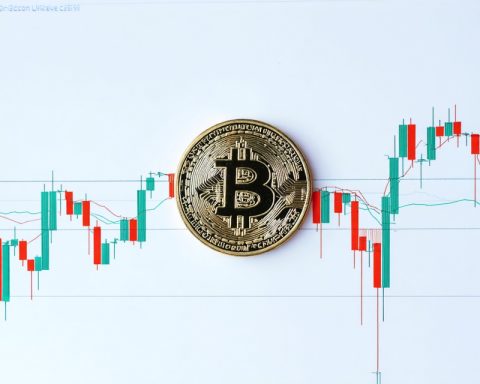- Global market turbulence hit hard as U.S. trade tensions led to $1 trillion losses in major American tech stocks within 72 hours.
- Key tech giants like Apple, Microsoft, and NVIDIA saw significant declines in market valuation, impacting investor confidence.
- The Dow Jones Industrial Average dropped over 3000 points due to fears of a prolonged trade war, while crude oil prices also tumbled.
- In contrast, the cryptocurrency market, led by Bitcoin, demonstrated resilience, maintaining a combined value of $2.7 trillion.
- Investors shifted funds from volatile equities to digital assets like XRP, BNB, and Cardano, seeking stability amid market uncertainties.
- Cryptocurrencies emerged as alternative harbors of value, indicating their growing role in the evolving financial landscape.
A storm of market turbulence swept through global financial landscapes recently, as the U.S. entered into a taxing trade spat that hammered the stock prices of some of the world’s most formidable tech giants. With Donald Trump’s imposition of fresh tariffs, a massive $1 trillion vanished from the valuations of major American companies within just 72 hours. Apple, Microsoft, and NVIDIA felt the sting most keenly, their combined market capitalization eroding dramatically as investor confidence wavered.
The Dow Jones Industrial Average mirrored this upheaval, plummeting over 3000 points—a jarring 7.4% dip—while crude oil prices collapsed, reflecting fears of disrupted global commerce. In this churn of economic anxieties, tech stocks endured calamitous losses: Microsoft recorded its steepest weekly decline since October, while NVIDIA and Apple also faced sharp slides in their stock valuations. Once hailed as $3 trillion titans, these stalwarts now grapple with staying aloft under the weight of geopolitical tension.
Investors responded not merely to the individual performance of these stocks, but to the specter of systemic risks posed by an escalating trade confrontation between the world’s two largest economies. Just 48 hours post-announcement, China’s retaliatory tariffs added more fuel to the fire, heightening concerns over a prolonged trade war and the ensuing ripple effects through tech supply chains.
Contrasting starkly with this strife, the cryptocurrency sector painted a markedly different picture. Amidst the volatile backdrop of traditional markets, the combined value of digital currencies clung tenaciously to the $2.7 trillion mark. Bitcoin led this impressive stand, its price unwavering above $80,000 even as global stocks reeled. This resilience beckoned investors seeking refuge from the tempest, redirecting capital from the beleaguered equities markets into digital assets.
As tech stocks floundered, cryptocurrencies like XRP, BNB, and Cardano fortified their footholds, hitting crucial support levels. This migration of funds underscored cryptocurrencies’ appeal as alternative harbors of value in uncertain times. Within a week, the leading altcoins demonstrated relative stability, their minor downturns clutching the coattails of Bitcoin’s steadfastness.
While the giants of tech and manufacturing catch their breath, battered but unbowed, the crypto arena continues to seduce with its promise of unencumbered value. Investors wary of conventional pitfalls have turned their gaze to digital horizons, where innovation and opportunity intersect amidst the winds of change. In this shifting landscape, the enduring vigour of cryptocurrencies stands as a testament to their burgeoning role in the modern financial tapestry.
The message is unmistakable: in times of fiscal uncertainty, adaptability becomes key, with savvy investors charting courses through these digital domains that promise possibilities beyond the traditional.
Cryptocurrencies Rise as Safe Haven Amid Market Turmoil
A Closer Look at Market Turbulence and Resilience
Trade War and Market Impact
Recent geopolitical tensions between the United States and China have heightened investor anxiety, resulting in significant losses across the U.S. stock market. The Trump administration’s imposition of new tariffs has erased $1 trillion from major tech companies like Apple, Microsoft, and NVIDIA within a brief period. The Dow Jones Industrial Average fell sharply by over 3000 points, while crude oil prices followed suit in a declining trajectory, driven by concerns about disrupted global commerce.
Additional Insights:
1. Sector-Specific Effects: These tariffs particularly affected sectors heavily reliant on global supply chains, like technology and automotive industries, amplifying fears of sustained economic decline.
2. Investor Behavior: Despite the broad impact, some investors have adopted a “wait and see” attitude, hoping for potential resolutions or trade negotiations, while others are cautiously reallocating assets.
Cryptocurrency Stability and Appeal
Contrasting with the stock market’s volatility, cryptocurrencies have gained traction as a perceived safe haven. Bitcoin, in particular, has maintained a stable value above $80,000, despite the volatile economic environment. Altcoins such as XRP, BNB, and Cardano have also held crucial support levels, attracting investors seeking alternatives.
Real-World Use Cases:
– Cryptocurrencies are increasingly being leveraged for cross-border transactions, with their decentralized nature providing a buffer against centralized economic disruptions.
– Digital assets enable users to manage assets without relying on traditional financial institutions, appealing to those seeking greater personal control over their investments.
Market Forecasts and Trends
– Growth Potential: The stability of cryptocurrencies during periods of traditional market volatility may reinforce their value proposition as a long-term investment.
– Regulatory Developments: Growing global adoption could lead to increased regulatory scrutiny, impacting how these assets are integrated into mainstream financial systems.
Pros and Cons Overview
Pros:
– Decentralization: Cryptocurrencies offer a degree of independence from centralized regulatory systems.
– Liquidity: High trade volumes facilitate the ease of buying and selling, attracting both retail and institutional investors.
Cons:
– Volatility: Despite recent stability, historical trends show cryptocurrencies are still prone to abrupt price changes.
– Regulatory Risks: Potential for future regulations could affect market dynamics and investor confidence.
Actionable Recommendations
1. Diversification Strategy: Investors should consider balancing their portfolios with a mix of traditional and digital assets to mitigate risks associated with market volatility.
2. Stay Informed: Keeping track of geopolitical developments and regulatory changes can provide insights into potential market shifts.
3. Risk Assessment: Conduct thorough risk assessments before investing, considering both potential returns and the volatility associated with cryptocurrencies.
—
For more insights into market trends and investment strategies, explore resources on [CNBC](https://www.cnbc.com) and [CoinDesk](https://www.coindesk.com).
By understanding the dynamics of both traditional and digital markets, investors can create strategies that enhance resilience against financial uncertainties.













